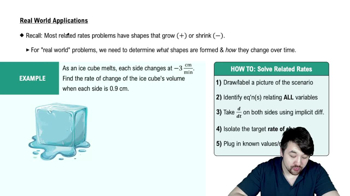Table of contents
- 0. Functions7h 52m
- Introduction to Functions16m
- Piecewise Functions10m
- Properties of Functions9m
- Common Functions1h 8m
- Transformations5m
- Combining Functions27m
- Exponent rules32m
- Exponential Functions28m
- Logarithmic Functions24m
- Properties of Logarithms34m
- Exponential & Logarithmic Equations35m
- Introduction to Trigonometric Functions38m
- Graphs of Trigonometric Functions44m
- Trigonometric Identities47m
- Inverse Trigonometric Functions48m
- 1. Limits and Continuity2h 2m
- 2. Intro to Derivatives1h 33m
- 3. Techniques of Differentiation3h 18m
- 4. Applications of Derivatives2h 38m
- 5. Graphical Applications of Derivatives6h 2m
- 6. Derivatives of Inverse, Exponential, & Logarithmic Functions2h 37m
- 7. Antiderivatives & Indefinite Integrals1h 26m
- 8. Definite Integrals4h 44m
- 9. Graphical Applications of Integrals2h 27m
- 10. Physics Applications of Integrals 2h 22m
4. Applications of Derivatives
Related Rates
Problem 112
Textbook Question
A spherical balloon is inflated at a rate of 10 cm³/min. At what rate is the diameter of the balloon increasing when the balloon has a diameter of 5 cm?
 Verified step by step guidance
Verified step by step guidance1
First, understand that the volume V of a sphere is given by the formula V = (4/3)πr³, where r is the radius of the sphere.
Since the balloon is being inflated, we are given the rate of change of the volume with respect to time, dV/dt = 10 cm³/min.
We need to find the rate of change of the diameter with respect to time, dD/dt, when the diameter is 5 cm. Note that the diameter D is twice the radius, so D = 2r.
Differentiate the volume formula with respect to time t to relate dV/dt and dr/dt. Using the chain rule, we get dV/dt = 4πr²(dr/dt).
Substitute the given dV/dt = 10 cm³/min and the radius r = 2.5 cm (since the diameter is 5 cm) into the differentiated equation to solve for dr/dt. Then, use the relationship dD/dt = 2(dr/dt) to find the rate at which the diameter is increasing.
 Verified video answer for a similar problem:
Verified video answer for a similar problem:This video solution was recommended by our tutors as helpful for the problem above
Video duration:
6mPlay a video:
Was this helpful?
Key Concepts
Here are the essential concepts you must grasp in order to answer the question correctly.
Related Rates
Related rates involve finding the rate at which one quantity changes in relation to another. In this problem, we need to determine how the rate of change of the volume of the balloon relates to the rate of change of its diameter. This concept is essential for solving problems where multiple variables are interdependent.
Recommended video:

Intro To Related Rates
Volume of a Sphere
The volume of a sphere is given by the formula V = (4/3)πr³, where r is the radius. Understanding this formula is crucial because it allows us to express the volume in terms of the radius, which is directly related to the diameter. Since the diameter is twice the radius, we can derive relationships between volume and diameter.
Recommended video:

Example 5: Packaging Design
Chain Rule
The chain rule is a fundamental principle in calculus used to differentiate composite functions. In this context, we will apply the chain rule to relate the rates of change of volume and diameter. By differentiating the volume formula with respect to time, we can find how the diameter changes as the volume increases.
Recommended video:

Intro to the Chain Rule
Related Videos
Related Practice





